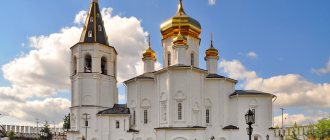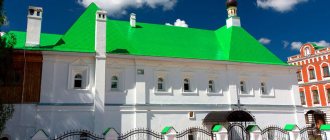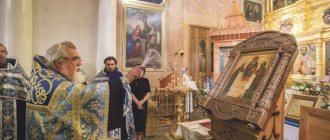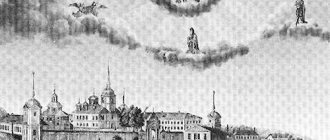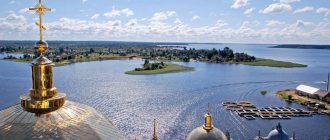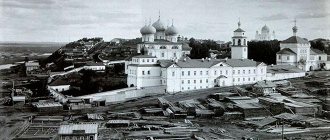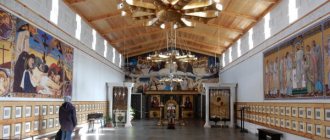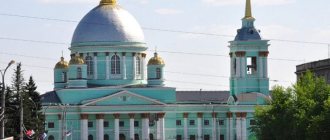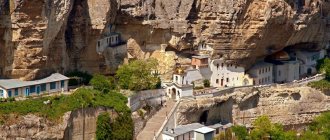The Alexander-Svirsky Monastery is one of the Orthodox spiritual centers operating in the Leningrad region. The men's monastery, regularly visited by pilgrims, travelers and tourist groups, is located in the village of Staraya Sloboda, 21 km from the town of Lodeynoye Pole. The remoteness of large settlements, virgin nature and the picturesque shore of Lake Roshchinskoye create a unique atmosphere of peace and harmony, promoting the awareness of spiritual truths and priorities.
View of the monastery from the shore of Lake Roshchinskoye, © Δημήτριος
Description of the Alexander-Svirsky Monastery
The Orthodox monastery, which includes famous architectural monuments of the 16th-17th centuries, was founded by Alexander Svirsky (1448-1533) at the end of the 15th century in the Olonets region (formerly Korelsky Land). At that time, these places were surrounded by dense forests and pagan settlements. The saint, now revered as a saint, quickly gained disciples and followers from among the indigenous population. The fame of the pious monk, which reached the most remote corners, attracted monks and lay people in need of prayerful help to his place of residence.
Even during the life of the Monk Alexander, two territorially separated complexes were formed in the monastery, connected by a path trodden along the lake:
- Trinity - at the fraternal cells;
- Preobrazhensky - next to the monastery cemetery.
Alexander-Svirsky Monastery in the 18th - early 19th centuries. called "Northern Lavra". He controlled about 30 monasteries and local deserts (remote monastic settlements).
The main part of the monastery's buildings was perfectly preserved, despite periodic raids by enemies and the difficult post-revolutionary period, when the relics of Alexander Svirsky were taken away, the sacristy was looted, ancient icons were destroyed, and the monks were dispersed or shot. In different years of the twentieth century, the territory and unique architectural monuments were used as a forced labor camp for prisoners, a nursing home, a psychiatric hospital and barracks.
The restoration of the Alexander-Svirsky Monastery began in 1997. The new inhabitants have made a lot of efforts, but today the complex is in need of major restoration efforts.
Church of the Intercession of the Blessed Virgin Mary with a refectory, © Masha Malinovskaya
Temples of the monastery
In the Trinity complex there are:
- Church of the Intercession of the Mother of God - built of stone in 1533–36. under Alexander Svirsky at the sacrificial funds of the Sovereign and Grand Duke of All Rus' Vasily III. The oldest (surviving) monastery church has a refectory;
- Trinity Cathedral - a stone structure erected in 1695–97. on the site of the wooden church of the same name, founded in 1508, and the stone church that replaced it in 1526. Inside the cathedral, frescoes created in 1709 have been preserved;
- belfry - a multi-span three-tiered structure with three tents appeared around 1646–48. Previously, the structure was wooden, with five tents;
- Church of St. John of Damascus - was built in 1716–18.
Three-tented belfry, © Lyudmila
On the territory of the Preobrazhensky complex there are:
- Transfiguration Cathedral - a wooden frame was erected in 1533, but during the period of the Polish-Lithuanian devastation (1618) it burned down. The stone structure was erected in 1641, and the chapel in the name of the founder of the monastery was erected in 1716. Later, the cathedral was reconstructed several times;
- Church of St. Zechariah and St. Elizabeth - added to the Transfiguration Cathedral in 1685;
- Gate Church of St. Nicholas the Wonderworker - located in the bishop's chambers above the entrance to the complex. Construction date unknown;
- Chapel of the Life-Giving Trinity - erected in 1791 on the foundation of a wooden church built by the founder of the monastery on the site of the appearance of the Most Holy Trinity to him;
- Chapel of Alexander Svirsky - located outside the Preobrazhensky complex. It was built in 1791 over a well, personally dug by the founder of the monastery and consecrated for the brethren;
- bell tower - erected in 1903-1904.
Gate Church of St. Nicholas the Wonderworker, © Masha Malinovskaya
In addition to the temples, the Alexander-Svirsky Monastery houses buildings - the bishop's, fraternal and cell buildings. Each of the two complexes is surrounded by walls. You can enter through the gate. In the open areas there are wide paths, plaster vases with flowers, lawns, benches, and lamps.
Founder of the monastery
The Monk Alexander Svirsky was born into a pious peasant family in the village of Mandera, in the Ladoga forests on the Oyat River. The child begged from the Lord, named Amos, was born on June 28, 1448.
At the age of 19, his beloved son secretly left his parental home: his father and mother started talking about marriage, Amos dreamed of becoming a monk, so he left home on Valaam.
Having crossed the Svir River, he stopped to rest on the shore of a forest lake in the middle of a pine forest. The traveler remembered the stop: the virgin beauty delighted, from the depths of the soul, fervent prayer flowed easily and freely.
After 7 years, the novice took monastic vows with the name Alexander. Following their son, their parents took monasticism, after whose death Alexander went to a secluded island in the Valaam archipelago and lived there, in a narrow and damp cave, for 10 years, eating the fruits of the northern forest.
The fame of Alexander's holy life spread throughout the area, but he went further away, settling in a memorable place among a dense forest on the shore of a lake.
Relics of Alexander Svirsky
The main shrine of the monastery is the relics of its founder. Even in the most difficult times, accompanied by enemy invasions, looting and fires, no one dared to touch the incorruptible remains of the saint. However, in 1918, the relics of Alexander Svirsky were seized, opened, examined, taken out and placed in one of the anatomical museums. The exhibit was listed for a long time as “the mummified body of an unknown man.” It took a lot of time to find the incorruptible flesh and examine it, but some historians continue to express doubts about the veracity of the shrine.
The second discovery of the relics of Alexander Svirsky took place on July 30, 1998, which became a major event for the reviving monastery.
Frescoes, © Lyudmila
The Alexander-Svirsky Monastery houses several more shrines, including:
- place of the appearance of the Holy Trinity;
- place of the appearance of the Blessed Virgin Mary;
- a copy of the Shroud of Turin;
- icons and frescoes;
- holy springs of drinking water.
Alexander-Svirsky Monastery - official website
The beginning of the Svir monastery
In 1508, during night prayer, the Divine Light shone around the hermit’s hut, and three light-like Angels appeared before him, commanding the monk to build a church and found a monastery.
The monk tremblingly asked what to name the church, and received the answer: “Beloved, as you see Him speaking to you in Three Persons, so build a church in the Name of the Father and the Son and the Holy Spirit, the Consubstantial Trinity.”
Soon hunters came across the monk’s hut, and the secret refuge became known. One of the hunters, Andrei Zavalishin, stayed with the monk and forever became his spiritual child. Those who wanted salvation and solitary prayer came to monk Alexander and settled nearby.
The monks worked and prayed together, Alexander prayed the most. That same year the wooden Trinity Church , and the monks insisted that Alexander become abbot of the monastery.
Saint Alexander, having become abbot, became even more humble - he wore rags, slept on the bare floor, and worked equally with everyone else. One day the steward asked the abbot to send one of the idle monks to chop wood. The monk, with the words: “I am idle!”, went into the forest himself to collect firewood.
Hegumen Alexander did not reproach anyone with a stern word, he gave all instructions in parables, constantly setting an example of humility and hard work for the brethren.
So in the remote Olonets region, in the virgin dense forests, a monastery was founded among the indigenous pagan population. Local residents - Karelians, Vepsians, Chuds - converted to the Christian faith, looking at the way of life of Elder Alexander, and came to the monastery for tonsure and prayer.
Hotels near the Svirsky Monastery
The Staraya Sloboda hotel is located 10 minutes from the complex. Guests can enjoy comfortable rooms with private bathrooms, refrigerators and TVs. On site there is a restaurant, playgrounds, an equestrian club, parking and a sauna. Free Wi-Fi and bicycle rentals are available to everyone.
Hotel near the Alexander-Svirsky Monastery on the map
Located a 5-minute walk from the monastery, the pilgrimage hotel offers shelter and food in the best hospitable traditions. Living here is subject to certain rules and responsibilities.
Patronal holidays
Dates revered in the monastery include:
- September 12 is the day of remembrance of the founder of the monastery, Alexander Svirsky;
- Day of the Holy Trinity;
- Holy Spirit Day;
- August 9 - the memory of Panteleimon the Healer is venerated;
- August 19 - Transfiguration of the Lord;
- September 18 - Saints Zechariah and Elizabeth are remembered;
- October 14 is the day of the Intercession of the Mother of God.
On December 4 (17), the memory of St. John of Damascus is venerated.
Schedule of work and services
The monastery is open daily from 06:00 to 20:00. On Sundays and holidays - from 08:00 to 20:00. The temple in which the relics of St. Alexander Svirsky, you can freely visit from Monday to Saturday from 10:00 to 17:00, and on Sunday from 12:00 to 17:00.
Trinity Cathedral, © Masha Malinovskaya
Anyone can come to church services. Tourists and excursion groups are allowed to view churches and chapels only after the end of services. Additional restrictions may concern issues related to the internal routine of the fraternity.
Schedule of services in the Alexander-Svirsky Monastery
Shrines
The main shrine, of course, is the incorruptible relics of St. Alexander of Svirsky. Believers can venerate them. Some were even lucky enough to observe the process of myrrh streaming. The saint's hands and feet are open to view. And although the relics are more than five hundred years old, they are perfectly preserved.
The incorrupt relics of St. Alexander are located in the Holy Trinity Alexander Svirsky Monastery
The monastery houses a copy of the Shroud of Turin and particles of the relics of other saints. There is also a healing spring here.
Ancient frescoes and mosaics are of historical and religious value.
Visiting rules
Since the monastery belongs to a closed religious organization, when visiting it you must follow certain rules. It is not allowed to come in beach clothes or too revealing clothes, including shorts, breeches and miniskirts. Women are advised to cover their heads with a scarf and avoid trousers (in extreme cases, the lower part of the body can be wrapped in a piece of any fabric). It would be appropriate to turn off mobile phones when entering churches and chapels.
Photographs and videos on the territory, in churches and chapels are allowed only with the blessing of the clergy.
The following is strictly prohibited on the territory of the complex:
- smoke;
- drink alcohol;
- run;
- make noise;
- to swear;
- walk on the lawns;
- sunbathe and swim;
- enter residential premises and outbuildings.
Iconostasis, © Lyudmila
Excursions for groups can only be carried out with the blessing of the abbot of the monastery and accompanied by representatives of the pilgrimage service. The application must be sent in advance. More detailed information is posted on the official website of the Orthodox monastery.
Myrrh-streaming of holy relics
After the transportation of the holy relics to the temple of the Great Martyr Sophia and her daughters, the flow of myrrh did not stop. Each time the intensity either intensified or became less noticeable, but the flow of the world did not stop for a second.
The elder’s relics were most powerfully myrrhized upon his return to his native monastery, after many years of oblivion . The process was observed by novices; they stood at the shrine of the saint, not daring to retreat a single step from the sacred relics.
Many noticed that the strength of the myrrh flow varied depending on who served and how people prayed, whether the monastery was filled with believers or there was complete silence in the church.
Metochion of the Alexander-Svirsky Monastery
Before the 1917 revolution, the monastery's courtyard was located next to the Yamsky market in St. Petersburg. Today this building houses a tuberculosis dispensary, and for the construction of a new courtyard another place was allocated at the address: lane. Chelieva, 10.
A small Church of the Nativity of Christ was erected on the territory, in which two shrines are kept:
- The Life-Giving Cross of the Lord with particles of important Orthodox relics;
- The Zhirovitsky Icon of the Mother of God is an exact copy given by the Dormition Zhirovitsky Monastery.
Official website of the Svirsky Monastery Metochion
Study of remains
For many years, believers did not know where the relics of their beloved saint were. And they were hidden by employees of the Military Medical Academy, which saved them from destruction. During the years of Soviet power, representatives of official science studied the body that came to them by chance. The examination was carried out by scientists and specialists in various fields:
- Anthropologist Banivolensky Yu.
- Anatomist, candidate of medical sciences Tvardovskaya M.
- Radiologist Borisov E.
- Professor Balin V.
They all believe that the state of the righteous man’s flesh is not subject to the laws of nature. The processes that take place in the saint’s tissues differ sharply from the usual ones. The monolithic remains have not decayed for hundreds of years; the preservation of the body and the color of the skin amaze researchers.
Nun Leonida (Safonova) is a candidate of biological sciences in the world, she took an active part in the search for the relics. As a scientist, she also could not help but pay attention to the unusual state of the body. First of all, what is striking is not only its preserved lifetime configuration, but also the condition of the muscle and connective tissue. This is very clearly visible in the contours of the face, the condition of the legs and hands.
- Normally, human tissue shrinks and when cut resembles compressed cardboard. Ligaments and vessels look like bundles of ropes. During the study, the saint’s subcutaneous tissue turned out to be white, white and airy. The evaporated liquid was replaced by air, which allowed the organs to maintain their previous appearance. No known embalming technology is capable of producing such results.
This degree of preservation is unique even if we compare the incorruptible relics of Alexander Svirsky with the remains of other Orthodox saints. The relics of Joasaph of Belgorod were taken for research. Radiologist E. Borisov found the tissues of his face to be fragile and lacking elasticity, their surface was dried out and rough, and the color of the tissues was brown. St. Alexander is still easily identified by his appearance. The skin is light, amber-yellow in color, practically free of wrinkles.
How to get to the Alexander-Svirsky Monastery
The distance from the Northern capital to the village of Staraya Sloboda, where the monastery is located, is about 270 km.
Direct flight from St. Petersburg
From bus station No. 2, located in St. Petersburg on the Obvodny Canal embankment No. 36, bus No. 863 departs daily. Travel time is 5 hours. The schedule can be viewed on the website.
With a transfer from St. Petersburg
Bus No. 963 passes through the Lodeynoye Pole bus station on the route St. Petersburg - Pitkyaranta. After getting off at the stop, you need to transfer to bus No. 89/91, heading towards Pogo and Kandushi, and get to the village of Svirskoye.
You can get to the Alexander-Svirsky Monastery from St. Petersburg by electric train No. 6012/6014, departing from the Ladozhsky railway station. He will deliver to the station. "Lodeynoe field" Then you will need to transfer to bus No. 89/91 or a minibus that runs between the railway station and the monastery complex.
- Schedule of buses departing from the bus station in Lodeynoye Pole.
- Schedule of electric trains running from Ladozhsky station in St. Petersburg to Lodeynoye Pole.
The courtyard of the Alexander-Svirsky Monastery in St. Petersburg can be reached by public transport to the stops “st. Novoselov" or "st. Telman":
- by bus - No. 12, 97, 118;
- by minibuses - No. K-12, K-97, K-365, K-385;
- by trams - No. 7, 27, 39.
Poklonny Cross on the highway at the turn to Staraya Sloboda
By personal vehicle
The fastest and most convenient route will take a little more than three hours. From the ring road of St. Petersburg you need to turn onto the Murmansk highway (also known as the E-105, R-21, Kola highway) and get to the Poklonny Cross. Next, turn left to the village of Svirskoye. From here to Staraya Sloboda - only 6 km.
In addition to the methods described above, you can get to the Alexander-Svirsky Monastery from St. Petersburg as part of excursion pilgrimage groups.
Alexander-Svirsky Monastery: video
Story
See also:
Main article about the life of the Holy Venerable Alexander of Svirsky
In what cases is an akathist read to Alexander Svirsky?
On prayer to Saint Alexander of Svirsky
Northern Lavra: Alexander-Svirsky Monastery
Icon of Alexander Svirsky: what does the saint help with
The relics of the saint were found twice. The first time was in the 15th century. The second is in XX. Then, over the course of six months, the remains were subjected to a thorough, comprehensive study: histologists, radiologists, dentists, and pathologists were invited to visit them, the purpose of whose work was to establish the authenticity of the relics. Finally, after a six-month scientific examination, the researchers came to the conclusion that in front of them was the body of Alexander Svirsky, a monk and ascetic who died in 1533.
Iconography: Alexander Svirsky, reverend. Dating: XVII century. Material: wood, tempera. Dimensions of the icon: height 31 cm, width 17.9 cm. Orthodox Russian saint, famous for the wondrous miracles performed during his life and after his death. Inv. No. Ж-1264. © Saratov State Art Museum named after. A.N. Radishcheva
First acquisition
The year is 1641. The monks of the Svirsky Monastery are dismantling the dilapidated stone Church of the Transfiguration of the Lord, installed over the grave of Elder Alexander, buried here. The shovel of a monk digging a ditch hits something hard, as it turns out later - the lid of a coffin. In reverent silence, the brethren put out the top board. A fragrance fills the air, and in the coffin the excited monks discover the Monk Alexander, untouched by decay. A tuft of beard can be seen from under the lectern (plate). The right arm, extended along the body, rests next to the staff, and the heel of the right foot, shod in a sandal, rests on the arch of the left foot.
Useful materials
On August 30, 1641, the first examination of the relics of St. Alexander of Svirsky took place. In the presence of four abbots of the Novgorod monasteries and the entire cathedral clergy, the relics were examined, as a result of which everyone “was confirmed in the incorruptibility of the body and in the fact that these were the relics of the first abbot of the Svir monastery, the Monk Alexander.” Two years later, the relics were transferred to the newly rebuilt Church of the Transfiguration and placed in a gilded shrine sent from Moscow by Emperor Mikhail Feodorovich himself.
The fate of the remains during the Civil War
The year is 1918. A detachment of security officers under the command of the Latvian rifleman August Wagner arrives at the Svirsky Monastery. They were given the task of destroying the body of the Monk Alexander. It is curious that the official campaign to open and remove the relics will begin only three months after this incident. Apparently, the fate of the defender of the Russian tsars and the prayer book about their succession to the throne, for whom the Monk Alexander was always revered, was of interest in the highest circles of the party apparatus. But on that day, the servicemen failed to debunk the “cult of dead bodies.”
Having opened the shrine containing the saint’s body, the security officers were dumbfounded: the safety of the remains of God’s saint was simply fantastic. Wagner was looking for any scientific explanation for this phenomenon, and he found it. This is what will subsequently be written in the report of the 8th Department of the People's Commissariat of Justice of the Congress of Soviets:
“When registering the liturgical property of the Alexander-Svirsky Monastery, a wax doll was discovered in a cast shrine weighing more than 20 pounds instead of the incorruptible relics of Alexander Svirsky.”
The security officers plundered the monastery, drank the wine they found in the altar, shot several people from among the monastic brethren who tried to oppose them, and left. The monastery would be robbed six more times by the Bolsheviks, but the relics would not be touched. Only on December 20, 1918, the remains of St. Alexander would be removed from the monastery and
“for the purpose of mercilessly fighting the enemies of the communist idea and socialist thought”
will be transported to a chapel sealed by security officers in the city of Lodeynoye Pole. From archival records it is known that they will later be sent to Petrograd and subjected to a forensic examination. Only after 80 years the relics of the righteous will return to the Svirsky Monastery.
Second Finding
Year 1998. To the Military Medical Academy named after. S.I. Monks come to Kirov. They explain that they have been studying the archives of Petrozavodsk, Moscow and St. Petersburg for many months in search of any information about the whereabouts of the body of St. Alexander Svirsky. There is evidence that the relics may be stored in the storerooms of the anatomical museum at the academy.
The catalogs were picked up, but the desired “exhibit” was not found. And then the head of the academy, Yuri Shevchenko, remembers that in the storage of corpses, where he had recently been on a visit, he was struck by one circumstance: one of the corpses strangely exuded a fragrance. Are these the relics that the monks are looking for?
Soon an expert commission was assembled, which included candidates of sciences and professors. Throughout the entire study, VMA specialists will be repeatedly amazed at the integrity of the saint’s integument. Even the skin of the face did not look dried out and wrinkled, as happens during mummification, but smooth and elastic.
This is what anthropologist Yu.D. noted in her report. Benevolskaya:
“The body of the subject is monolithic, whole, not subject to decay, the color of the body is waxy. <> The head is without hair and beard, slightly turned to the left shoulder. The facial features are well preserved. The mouth is slightly open. <> The wings of the nose and its tip have retained almost the intravital configuration, thickness, and modeling. <> The preservation of the body is amazing.”
The total research work of the specialists took forty-five pages of printed text. The final report of the examination states:
“The mummified corpse of a man, not listed in the catalogs of the fundamental museum of the department, on the basis of the collected conclusions can be identified as the relics of the holy Venerable Alexander of Svirsky.”
While preparing the body for the X-ray procedure, the staff suddenly noticed that the sheet under the remains of the reverend was wet. It turned out that she was saturated with the world, which began to stand out from the pores of the skin and flow especially abundantly from the feet of the saint.
30
July
1998
With the blessing of Metropolitan Vladimir of St. Petersburg and Ladoga, the shrine was opened for worship by believers in the Church of St. mcc. Faith, Hope, Love and their mother Sophia.
On November 23, 1998, the relics of St. Alexander were finally transferred to their final resting place - to the Holy Trinity Alexander of Svirsky Monastery.
When are the relics opened for pilgrims?
The holy relics of the righteous are revealed on the days of glory and reverence for the memory of Alexander Svirsky on April 30 and September 12, on the Orthodox Trinity and on the Transfiguration.
Pilgrims will have the opportunity to receive communion and come into contact with the incorruptible body of the elder wonderworker. There are many secrets and mysteries associated with the relics of the holy elder. At the end of the 19th century, an icon was painted from his face, it was so well preserved 3 centuries after his death. The phenomenon of myrrh-streaming of relics is studied by Orthodox priests and lay researchers. The power of faith, wisdom and incorruptible remains of the New Testament saint are highlighted in the documentary film “Alexander Svirsky. Protector and patron":

